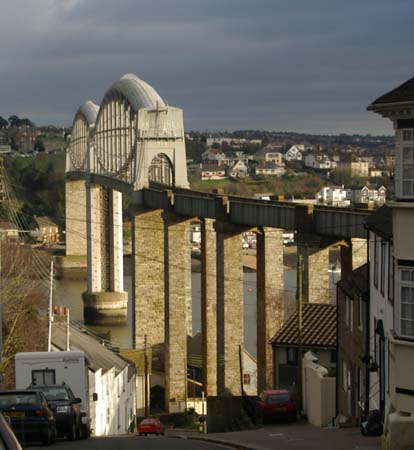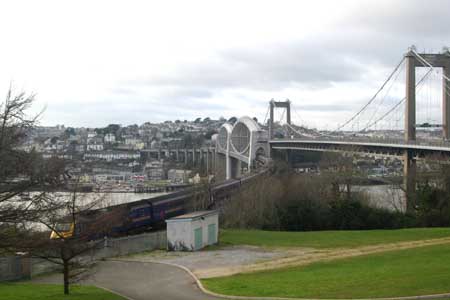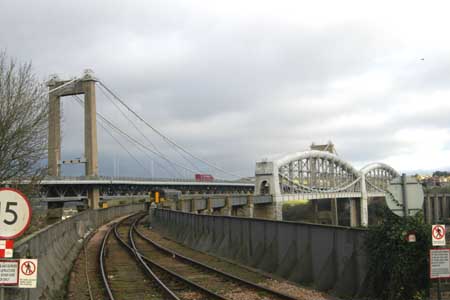
The Royal Albert Bridge was designed by the famous Victorian engineer, Isambard Kingdom Brunel, to carry the then broad gauge Cornwall Railway Company line from Plymouth to Falmouth over the River Tamar between Devon and Cornwall at Saltash.
The Royal Albert Bridge Page |
|
|
The Royal Albert Bridge was designed by the famous Victorian engineer, Isambard Kingdom Brunel, to carry the then broad gauge Cornwall Railway Company line from Plymouth to Falmouth over the River Tamar between Devon and Cornwall at Saltash. |
|
After several designs were rejected, the final plans were drawn up and approved in 1848. The bridge has two main spans of 455 feet, with a clearance to the water of 100 feet. The centre stone pillar was constructed inside a huge cylinder that was constructed in two halves on the Devon shore and floated to the centre of the river and then lowered into position. When this stonework reached a height of 12 feet above the water, it was capped off to form the base on which octagonal columns stand to support the centre of the 2 main trusses. Whilst this was being done, the 2 trusses were being constructed, also on the Devon shore. Each truss consists of an oval tube made of wrought iron plates, to which suspension chains (which were originally for the Clifton Suspension Bridge - that project being halted due to lack of funds) were hung. The decking that carries the track bed was suspended from these chains. |

|

|
The bridge was officially opened by His Royal Highness Prince Albert on 2nd May 1859, but the first train had run from Plymouth to Truro on 11th April. Brunel was not present at the opening as he was abroad trying to recuperate from illness, and when he did return to England, the only way he could view his masterpiece was by being taken slowly across on a flat wagon. He died shortly afterwards on 15th September 1859 at the age of 53. |
The track was converted from broad gauge to standard gauge over the weekend of 21st and 22nd May 1892. The vertical hangers were strengthened with a horizontal light lattice-work girder during the 1930s. For its centenery celebrations in 1959, the bridge was floodlit each evening from May to September. Additional suspension links were fitted between the suspension chains and the decking in 1969 at a cost of £80,000. The lettering at each end of the bridge, a memorial to its designer from the directors of the Cornwall Railway, reads 'I.K. BRUNEL, ENGINEER. 1859'. It was produced by Plymouth Ironfounders at a cost of £15.
The total length of the bridge is 2200 feet, with each of the 455 foot long trusses weighing 1060 tons, and the 10 foot diameter octagonal support columns in the centre weighing 100 tons each. Construction cost: £255,000